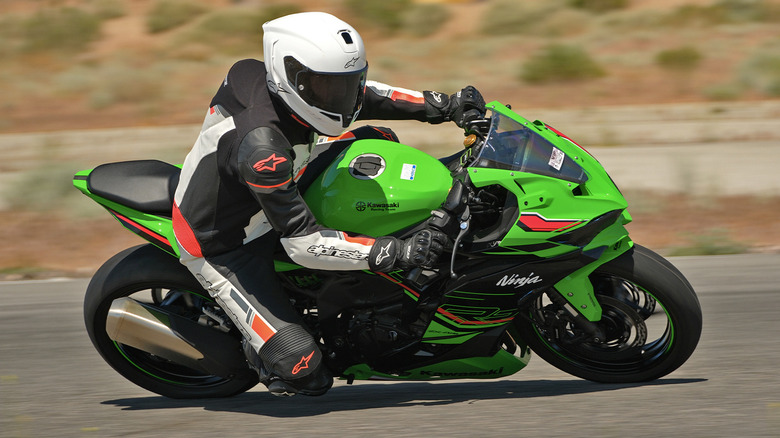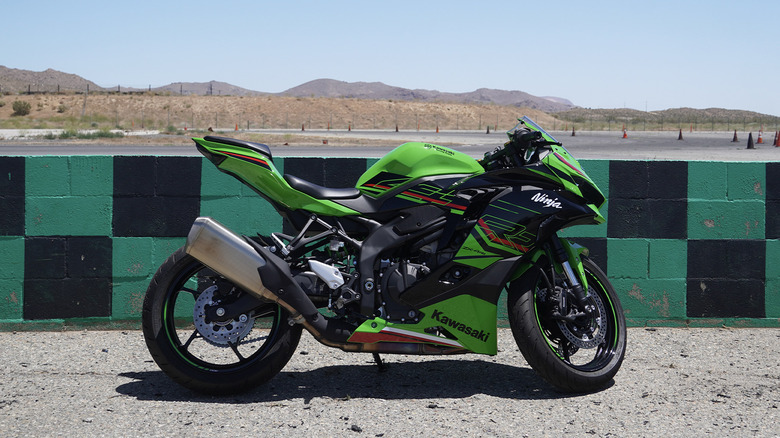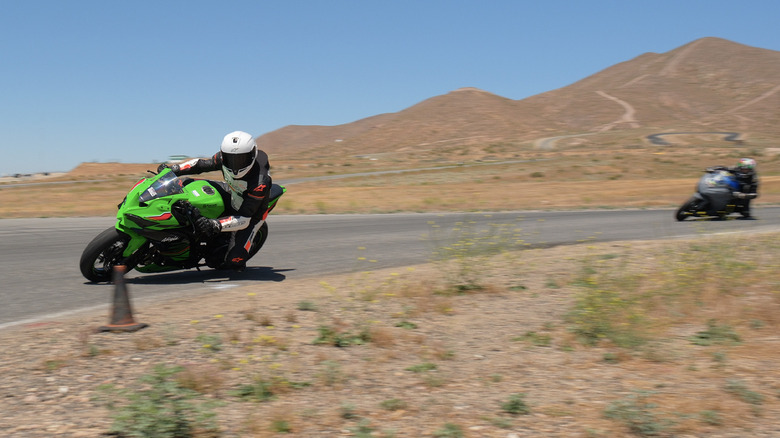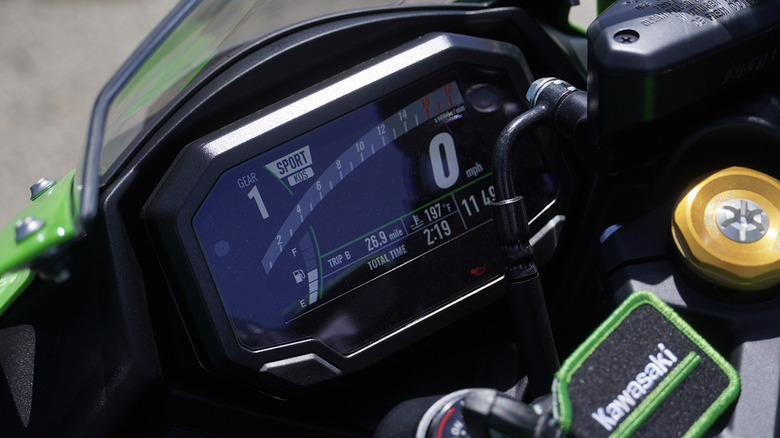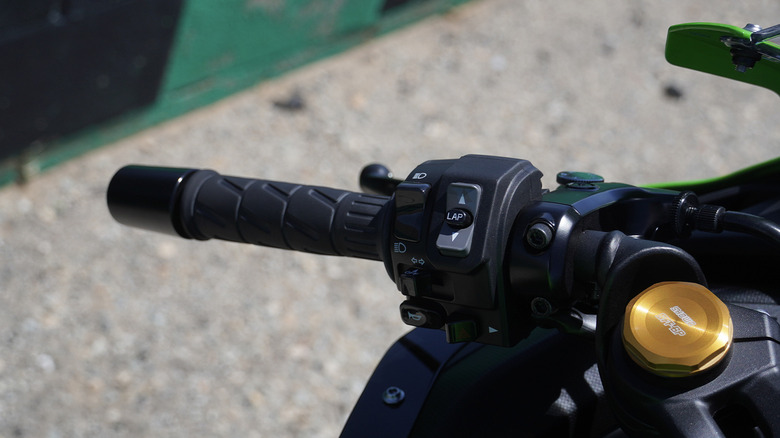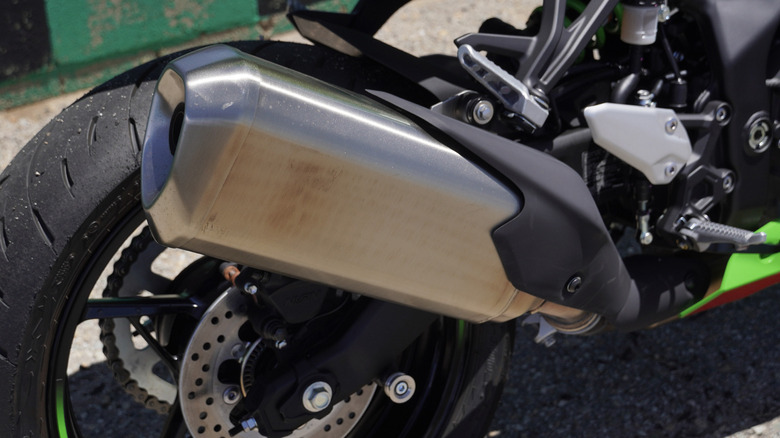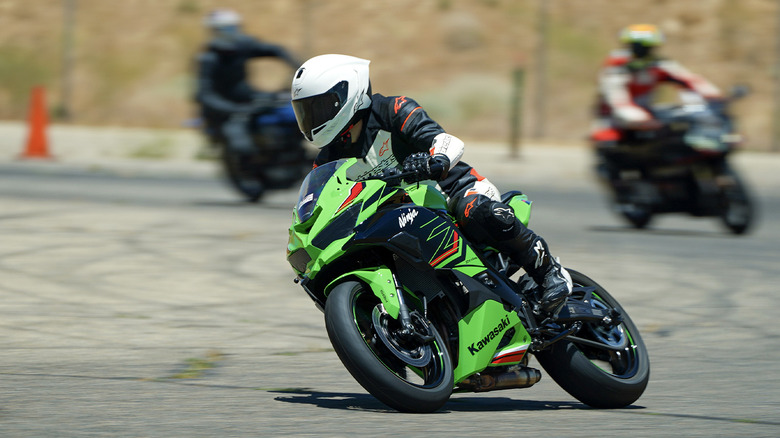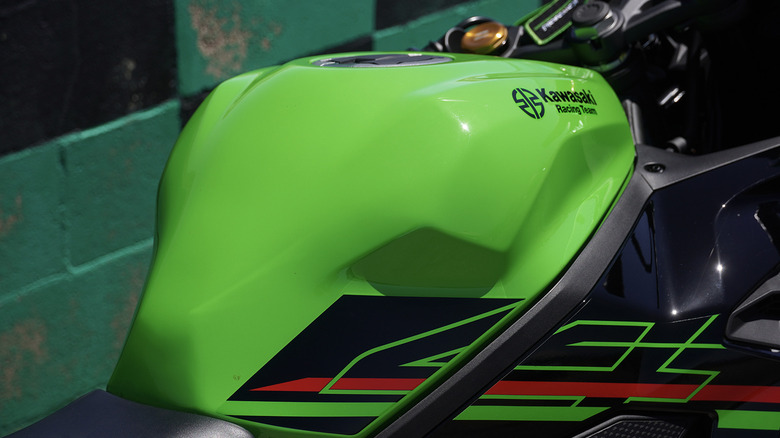2024 Kawasaki Ninja ZX-4RR Review: For Track Rats And Sport Bike Newbies Alike
- Screaming 399cc inline-four engine revs to 16,000 RPM
- Lightweight with nimble handling
- All the goodies for true track rats
- Starts below $10,000
- Still a 400, not insanely quick
- Twitchy enough to reveal rider deficiencies
- Not actually as light as it feels
Very few new motorcycle launches over the last two years managed to pique my interest quite as much as the highly anticipated Kawasaki Ninja ZX-4RR. Despite slotting in with a 399cc engine–the same displacement as the more entry-level Ninja 400–the ZX-4RR arrived packed to the brim with a ton of features in addition to a screaming inline-four capable of revving above 16,000 RPM, all while priced below $10,000. So of course, I jumped at the chance when Kawasaki recently invited me to Streets of Willow for a day proving the ZX-4RR's capabilities as the perfect motorcycle for sport bike beginners and track rats alike.
On paper, that engine marks the single biggest difference that sets the new ZX-4RR apart from the more basic Ninja 400, bumping output from 44 horsepower out of a parallel twin to 79 horsepower from the inline-four fed by a nifty ram air setup. Torque for the four-cylinder mill also peaks at 29 lb-ft, when wound up to a ridiculous 13,000 RPM.
Almost more importantly, though, the 2024 ZX-4RR ABS arrives fully featured with all the track goodies, including an up and down quickshifter, an assist/slipper clutch, easily adjustable suspension, selectable traction control and ABS settings, smartphone connectivity, and four ride modes displayed on a 4.3-inch screen. There's even a lap timer button right on the left thumb switchgear—clearly, Kawasaki wants to attract dedicated track riders, but with dual 290-millimeter front brake rotors, slightly less aggressive seat and handlebar ergonomics, and a relatively tame exhaust in stock form, the ZX-4RR also positions well as a sport bike for riders on a budget.
The perfect track to test the new Ninja
Early on a chilly morning out at Streets of Willow, I arrived and immediately pulled on my full leathers. Coincidentally, I had just ridden the same track a few weeks prior on a Honda CBR600RR and figured that on the Kawasaki, I might drag my knees even more. On that day, more than a couple of other riders already showed up on privately owned ZX-4RRs, which only made me more excited to try out the bike myself.
The mid-size circuit at Willow Springs International Raceway—a facility currently for sale, coincidentally—Streets of Willow's short straightaways, tight turns, and modest elevation gains make the track perfect for smaller displacement motorcycles. Kawasaki dropped me into an event put on by Compact Octane Track Days, and we planned to run Streets of Willow clockwise. The repaved surface provides (mostly) consistent traction over the whole course, though I personally prefer riding counterclockwise after having driven the track for multiple days in sports cars.
In the clockwise configuration, an uphill at the first right turn gives way to two moderately tight hairpins, the latter of which starts on a downhill slope and commonly catches riders out on the first few laps before tires warm up. Then, a few transitions on somewhat level ground give way to the famous banked bowl, before a long, steady downhill that motorcycles can just about straightline. Going counterclockwise, that relatively straight uphill nonetheless translates to higher speeds entering the bowl, which perhaps explains why motorcyclists tend to prefer riding Streets clockwise. My main concern on the track, however, is always the so-called "skid pad" just before the straightaway when running clockwise, a gritty and cracked flat section that never received new asphalt. Leaning over on the skid pad at the end of a hard lap on the rest of the more predictable surface always makes me nervous.
Adjusting to a lightweight track bike
On the ZX-4RR, I pulled out for an easy first session hoping to warm up my body and the bike. Track temps already hinted at the heat predicted to arrive by mid-morning, but with an eye on the bike's coolant temps and without revving too high, I tried to let the tires absorb some warmth as I adjusted to the new Ninja itself. I noticed first that the handlebars seemed higher than expected, and the seat a little lower. The throttle also spun up that compact inline-four happily, before settling into a smooth idle.
Even pulling away, the light clutch action surprised me. Simply by releasing the clutch lever quickly, though, the slipper clutch got me rolling and I shifted into second, then third smoothly as I crept up to track pace. I kept revs low, in my mind waiting until I saw 180 degrees on the coolant readout gauge (not sure why, but I always have some mechanical sympathy even for bikes that aren't my own). I used the clutch to rev match up and downshifts through the first few turns, before remembering the quickshifter—clearly, I still carried some of the memories of tracking the CBR600RR, which though still one of Honda's fastest bikes essentially hasn't changed for the US market since 2013.
More than just straightline speed
Without getting anywhere near top speed, the reduced power output stood out versus the Honda, too. But all-out speed isn't exactly the point here anyway, instead I'm supposed to be learning how to ride more smoothly, corner harder, and improve control over the bike placement on the racing line. And in all those regards, the ZX-4RR immediately revealed my vast deficiencies.
The bike's center of gravity rides low enough to mask a surprising wet weight of 416 pounds. Without looking up the stats online, I would have guessed somewhere in the vicinity of 350 to 360 pounds, or about 10 to 15% less than reality. But still, my own mass—170 pounds plus leathers and boots and helmet, etc—meant I made up about half again the motorcycle's weight, so every movement of my body made a huge difference everywhere on the track.
For the first few laps, I rode twitchy, almost to the point of nervy. Seemingly every muscle contraction, every ounce of countersteer, even each little pivot of my heels showed up in my line around turns. The feedback illuminated how much more purposefully I needed to ride this bike, and as I adapted to the interplay between bike and rider, I ended up hanging off the seat far less because of those seemingly exaggerated responses.
A knee down, or two, or three
The 399cc engine and tires got up to temp relatively quickly, though, and soon enough I found myself pulling full throttle on the straights, cracking above 100 miles an hour occasionally when I remembered to glance down at the speedometer. I leaned into the first uphill turn much earlier than on the CBR600RR, too, thanks to the confidence inspired by earlier and smoother downshifts of the quickshifter. On the Honda, with its outdated (or budget-friendly) cable clutch, I experienced more than a few moments where bad throttle blipping caused rear tire chirps and squiggles. Accordingly, I tried to stay as upright as possible while changing gears. Not so on the Kawasaki, regardless of whether I used the clutch or quickshifter.
I learned to keep flying, progressively adding and then trailing off brake pressure into and then through the corners. My leans started to get lower, at higher speeds, as I kept up maintenance throttle and edged my lines closer to apex. By the second session on track, I felt almost dialed but still wanted the tires to warm up more after a short break before I started pushing too much harder. And yet, in that second session I already began dragging my left and right knees, putting more weight on my outside foot and countersteering with the low hand confidently.
Tall guy on a small bike
At this point, I wasn't necessarily riding too fast—keeping the engine happier up in the 11,000 to 13,000 RPM range helped, but to an extent, the bike's small size prevented me from getting quite 100% comfortable. At 6'1" with long limbs, I tend to look and feel like a bit of a frog on a log on sport bikes, but even consciously trying to slide my hips rearward never quite made the ZX-4RR feel right. Instead, I needed to bend my downhill knee more, while making sure to keep the revs higher up than usual to provide better modulation through corners lest I upset my delicate front-to-rear weight transfer.
The few times when I tried to stay in a higher gear coming out of a turn, the ZX-4RR's lack of low-end torque left me in the lurch. Entirely my fault, of course, and another lesson learned about braking and shifting points on the track. When I nailed every up and downshift, though, the gear ratios seemed just about perfect to stay in the sweet spot of second and third, depending on the specific turn at Streets of Willow. And once I pulled off after the second session, the edges of the rear Dunlop Sport Max GPR300 tires in addition to my knee pucks clearly showed a bit of wear.
This Ninja begs for some easy modifications
A pair of track slicks might have helped me step up the confidence to lean harder, but again, I always ride a little easier on bikes I don't own. And the Dunlops seem like a bit of an odd choice from Kawasaki for such a specifically optimized bike that most buyers will probably want to take to the track. Same, too, for the two-up seat and passenger footpegs—but Kawasaki clearly wanted me to experience the ZX-4RR in stock form.
A few modifications might help dial in the bike for someone my size, maybe a steering damper or slightly firmer settings for the forks and rear shock. And when pulling up toward that screaming redline, I wanted more of a shriek from the exhaust rather than a steady hum—an Akrapovic setup that any real track riders will probably want, or straight pipes if they never plan to ride the ZX-4RR on public roads.
Finding the flow on the Ninja ZX-4RR
Running against the rest of the riders at Compact Octane left me facing something of a conundrum, too: either go out with the group of faster riders on liter bikes and get passed constantly on straightaways then reel the big fish once the corners tighten up, or stick with the sub-600 bikes and find more of a flow while bunched up in the pack.
I prefer the flow, typically, and being able to watch other riders at similar pace falls more in line with this Ninja's spirit as a trainer bike, too. I spent four more sessions honing my own skills and feeling the ZX-4RR accept every little bit of extra pace I found, all while subtly begging for more than my own skills seemed capable of producing.
A perfect trainer or beginner sport bike
Once I arrived back home that evening, I immediately hopped back on the CB600RR to confirm that my impressions out at Streets of Willow lined up with reality. Sure enough, the Honda feels more racy and, without a doubt, much heavier—even if it only weighs about 10 pounds more. The ergonomics alone make for a big difference, with lower and narrower handlebars and a seat height of 32.4 inches versus the Ninja's 31.5 inches. Even on a quick lap around the neighborhood, I immediately started moving my hips off the saddle far more than on the ZX-4RR.
Then again, in a tuck on the CBR, I remembered more wind buffeting and a less ideal viewing angle of the gauge screen. Part of the difference might come down to my incredible new Alpinestars Supertech R10 helmet, which drastically improves aerodynamics and visibility versus the 6D ATS-1R that I wore at Streets of Willow on the Honda. Either way, more testing is required, but I suspect that for my physical size, a bike in the 600 class still fits a bit better for track and street riding alike.
But then again, the whole purpose of a ZX-4RR would be to hone my skills to the point that my inputs get smoother and more fluid as I find more speed. And all the new features of this newest Ninja definitely make a solid case against the outdated CBR600RR, until the European update arrives Stateside, anyway. Still, priced at $9,399 to start, the ZX-4RR is such a weapon and reveals both good and bad habits with ease. I prefer it in the base black, rather than the KRT Edition green, and can confirm that for the road and track alike, the little screaming inline-four pumps out plenty of power for real-world riding, even for someone as spoiled by hardcore liter bikes as myself.
